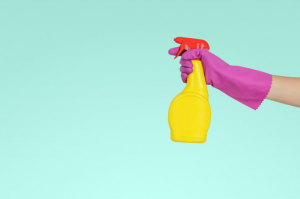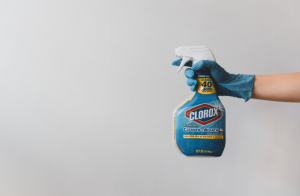
[Source: Unsplash]
Hardwood floors are a beautiful choice for flooring. Their durability and value retention are just a couple of the many reasons to use them. It’s good practice to clean once or twice a week to keep things nice and tidy. That said, care must be taken to not damage them when trying to do so. The use of the wrong product can stain, scratch, weaken, or even destroy the boards over time. In this article, we will go over all the products you should avoid using, as well as talk about what you should be using instead.
Avoid Wet Mops
One of the worst things you can use on your floor is something you may be completely unaware of being a problem. Wood naturally absorbs water, especially when not given a good enough finish. By using a wet mop and bucket, much of the water you’re using on the surface to remove grime is going to get soaked up into the boards. This will cause the boards to swell, bend, and eventually even pop out of alignment altogether.
What to do instead
Start by vacuuming up the floor. Ditch the water entirely. Instead, use a dry microfiber mop head to sweep up the dirt, then follow it up with either a specially wetted microfiber mop head that uses proper wood floor cleaning solution. We recommend using the MacWoods hardwood floor cleaner as the cleaning solution for this case. If you don’t have the special mop or cleaning solution, the next best thing would be to lightly dampen a cloth with warm water before wiping down the floor. Excessive water can cause damage.
Don’t Use Steam to Clean
You should never use a steamer on your hardwood. This is a recipe for destruction, as just like with a wet mop, will eventually cause water damage and warp the boards. It’s actually even worse than a mop, as the water isn’t just passively sitting on top of the boards, but actively superheated and injected right between them. This will cause the wood to peel, flake, discolor, not to mention all the problems caused by just a wet mop alone.
What to use instead
As before, use a wood floor cleaning solution instead. If you’re steaming because you’re trying to clean a certain spot, just get down and use a rag with the solution. A little elbow grease often does the best job.
Vacuums Can Be Bad, Too
Vacuums are great for getting up all kinds of different dirt and debris. The problem isn’t the suction itself, but rather the beater bars as well as the hard plastic wheels on the back of the unit. Just like how you wouldn’t want to use a rolling office chair on hardwood without a rug, so too would you want to avoid using a vacuum without proper padding.
What to use instead
A dustpan and broom will often work best here. You also can use a vacuum if you really want to, but If you’re going to use one, make sure that it has soft rubber wheels and that you turn off the beater bar before going over the wood. Use caution and you should be fine.
Using the Wrong Cleaning Solution
This is a situation where it may not even necessarily be your fault. There are a dearth of cleaning solutions that market themselves as safe to use on wood when they aren’t safe for that at all. Knowing what to use and what to avoid is vital for the longevity of the wood. The following is a list of the solutions that we don’t recommend you use.
Polishes
While this won’t necessarily damage your wood, it’s usually a bad idea to use it. While it will initially make the boards look brand new, it won’t last long. Eventually, it will lose the shine and leave an ugly and waxy floor. This now useless coating will need to be entirely sanded off before you can put any new coat on. Just steer clear if you can help it.
Ammonia
This is a solid NEVER for wood. Ammonia has tons of different uses all throughout the house, but hardwood floors are not one of them. The chemical will outright damage the wood by dissolving the very fibers in it, keeping it intact.
Bleach
Speaking of bleach, this is another one for the “AVOID AT ALL COSTS” list. It can discolor the boards permanently, even when used in small amounts. There is no good use-case for this product on hardwood floors, you’re only setting yourself up for failure.

[Source: Unsplash]
Vinegar
Using vinegar and water as a homemade hardwood floor cleaning solution can have a negative effect on your hardwood floor. It’s important to remember that when you clean your hardwood floors, you aren’t actually cleaning the wood—you are cleaning the chemical finish on the wood. The finish is the protective layer of your hardwood floors.
Windex (And the Like)
It’s more useless than anything. Not only does this usually contain abrasive ingredients just like in ammonia that damage the floor, but it also won’t do much of anything beyond that. The cleaner simply isn’t designed to get anything off wood. If you want to use a spray, use the MacDonald Hardwoods Floor Cleaner. Take some of it and pour it into a spray bottle, then spray away. Use a microfiber cloth to wipe it off when done. This is much more effective, lets you tackle the problem the same way, and comes with none of the risks.
What Should I Use Instead?
MacDonald Hardwood Floor Cleaner, which you can pick up in our store, is a great option for cleaning hardwood floors. If you can’t get a hold of that, you can use a damp cloth (ideally, a microfiber cloth) with warm water to clean.
Conclusion
Your wood floor is precious. It has a value that, when properly taken care of, can last full generations. As much as wood floors are usually known for being durable, there are still plenty of ways to successfully damage them, as outlined in this article. By avoiding the products listed here, you will be saving the value of your home, not to mention avoiding unnecessary repair costs.